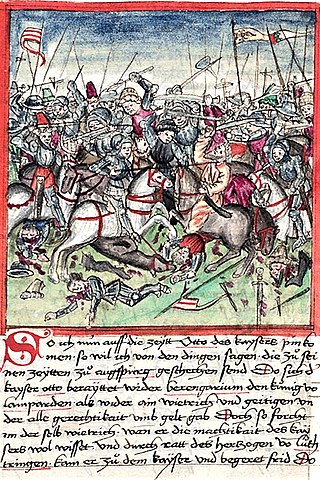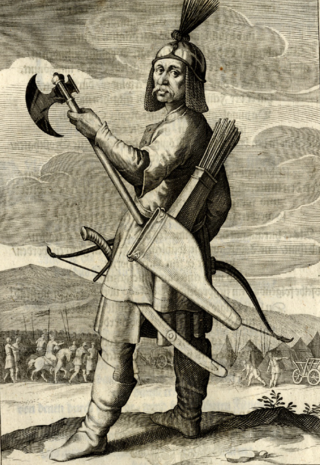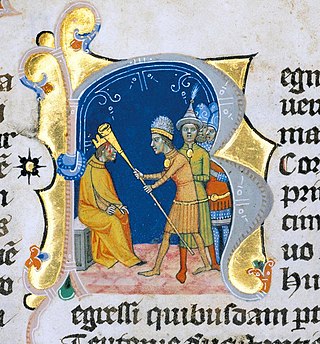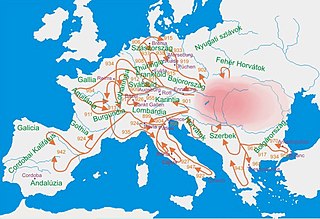
Year 955 (CMLV) was a common year starting on Monday of the Julian calendar.

Year 954 (CMLIV) was a common year starting on Sunday of the Julian calendar.

Ferenc Puskás was a Hungarian footballer and manager, widely regarded as one of the greatest players of all time and the sport's first international superstar. A forward and an attacking midfielder, he scored 84 goals in 85 international matches for Hungary and later played four international matches for Spain as well. He became an Olympic champion in 1952 and led his nation to the final of the 1954 World Cup. He won three European Cups, ten national championships and eight top individual scoring honors. Known as the "Galloping Major", in 1995, he was recognized as the greatest top division scorer of the 20th century by the IFFHS. Scoring 806 goals in 793 official games during his career, he is the seventh top goal scorer of all time by the RSSSF.

Lehel, a member of the Árpád dynasty, was a Magyar chieftain and, together with Bulcsú, one of the most important figures of the Hungarian invasions of Europe. After the Magyar defeat at the Battle of Lechfeld, he was executed in Regensburg.
Farkas is a Hungarian surname and a given name. In Czech and Slovak languages it is rendered as Farkaš.

Kontroll is a 2003 Hungarian comedy–thriller film. Shown internationally, mainly in art house theatres, the film is set on a fictionalized version of the Budapest Metro system. "Kontroll" in Hungarian refers to the ticket inspectors checking to ensure a rider has paid their fare. The story revolves around the ticket inspectors, riders, and a possible killer.

Bulcsú Székely is a Hungarian water polo player who played on the gold medal squad at the 2000 Summer Olympics.
Tamás Märcz is a Hungarian water polo player who played on the gold medal squad at the 2000 Summer Olympics. He was the head coach of Hungary men's national water polo team between 1 January 2017 and 18 July 2022.

Bucsu is a village in Vas County, Hungary, in the vicinity of Szombathely. It is on the border with Austria, and there is a road crossing the border from Bucsu to Rechnitz and Schachendorf.

Dozmat is a village in Vas County, Hungary.
Zombor, also referred to as Gyula II or Gylas, was a Hungarian tribal leader in the middle of the 10th century. He visited Constantinople, where he was baptized in 952 with the baptismal name of Stephen.
Székely is a Hungarian language surname. The word "Székely" refers to Hungarian people from the historical region of Transylvania, Romania.

Apc is a village in Heves County, Hungary, beside the Zagyva river, under the Mátra mountain ranges. As of 2022 census, it had a population of 2452. The village is located 2.2 km from the Hatvan–Fiľakovo railway line, 3.5 km from the main road 21 and 15.7 km from the M3 motorway. The village has its own train station under the name Apc-Zagyvaszántó in the administrative area of the village, but it is closer to Zagyvaszántó.

The Hungarian invasions of Europe took place in the 9th and 10th centuries, the period of transition in the history of Europe in the Early Middle Ages, when the territory of the former Carolingian Empire was threatened by invasion from multiple hostile forces, the Magyars (Hungarians) from the east, the Viking expansion from the north, and the Arabs from the south.
Bulcsú Kál Hoppál is a Hungarian theologian and philosopher.

Bulcsú was a Hungarian chieftain and military leader in the 10th century. He held the title of harka. Despite he was not a member of the ruling Árpád dynasty, he was one of the most important figures of the Hungarian invasions of Europe. He led military campaigns in directions to the north, west and east either in the period 930–950s.

Teréz Ferenczy was a Hungarian poet. She came to wider public prominence as a result of her shocking suicide, and most of her poems were published only posthumously. By the final part of the nineteenth century her work had been largely forgotten. It has undergone a revival since the 1970s, however.
Bulcsú from the kindred Lád was a Hungarian Catholic prelate in the 13th century, who served as Bishop of Csanád between 1229 and 1254. Prior to that he functioned as Provost of Győr from 1221 to 1229. He was chancellor in the royal court of King Andrew II of Hungary between 1228 and 1229.
Bulcsú Révész is a Hungarian professional snooker player. He is the first ever professional snooker player from Hungary
Hoppál is a surname. Notable people with the surname include:
This page is based on this
Wikipedia article Text is available under the
CC BY-SA 4.0 license; additional terms may apply.
Images, videos and audio are available under their respective licenses.










